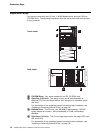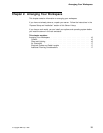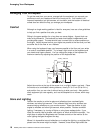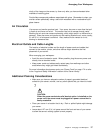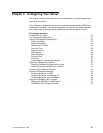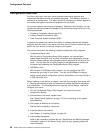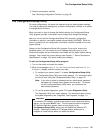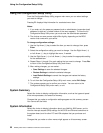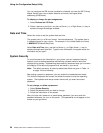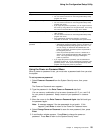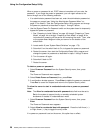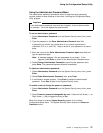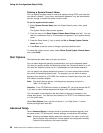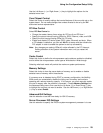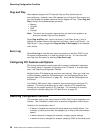Using the Configuration/Setup Utility
Product Data
Select this choice to view system information such as the machine type and model,
the system serial number, the system board identifier, and the revision level or
issue date of the flash electronically erasable programmable ROM (EEPROM) and
BIOS.
System Card Data
Select this choice to view the system board model, submodel, system serial
number, system board identifier, DASD backplane identifier, power backplane
identifier, and identifiers for power supply 1 and power supply 2.
PCI Routing
Select this choice to view the interrupt request (IRQ) settings for PCI adapters and
for the Ethernet, SCSI, and other controllers on the system board. See “PCI Bus
Control” on page 29 for information about changing the PCI IRQ settings.
Devices and I/O Ports
Software recognizes ports from their port assignments. Each port must have a
unique port assignment. The Configuration/Setup Utility program normally handles
this, but you might have special hardware or software that requires you to change
these assignments.
Note: Serial port A can be shared by the system-management processor and
operating system. Serial port B is used by the operating system only.
Management port C is controlled exclusively by the system-management
processor, cannot be used by the operating system, and cannot be
configured using the Configuration/Setup Utility program. See the
“Advanced System Management Information” section of this
Server Library
for information about configuring serial ports A and C.
Select the Devices and I/O Ports choice to view or change the assignments for
devices and input/output ports.
You can add serial ports by installing a serial adapter in an expansion slot. See
the documentation that comes with the serial adapter for information about port
assignments.
You can configure the parallel port as standard, as bidirectional, as an Extended
Capabilities Port (ECP), or as an Enhanced Parallel Port (EPP). Bidirectional,
ECP, and EPP are all bidirectional modes; in all three modes, data can be both
read from and written to a device. ECP and EPP are industry-standard,
high-performance bidirectional modes. Which one of these modes you choose
depends on what mode your device supports.
Note: When you configure the parallel port as bidirectional, ECP, or EPP, use an
IEEE 1284-compliant cable. The maximum length of the cable must not
exceed 3 meters (9.8 feet).
You can configure the mouse and diskette controller as enabled or disabled, and
configure the type of diskette drive.
You can view the type of video controller and the amount of video memory
installed.
Chapter 3. Configuring Your Server 23



